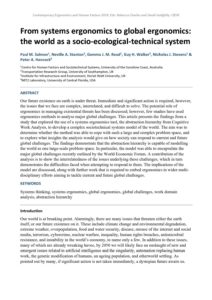| Document | Author Paul M. Salmon, Neville A. Stanton, Gemma J. M. Read, Guy H. Walker, Nicholas J. Stevens & Peter A. Hancock |
| Abstract Our future existence on earth is under threat. Immediate and significant action is required, however, the issues that we face are complex, interrelated, and difficult to solve. The potential role of ergonomics in managing existential threats has been discussed; however, few studies have used ergonomics methods to analyse major global challenges. This article presents the findings from a study that explored the use of a systems ergonomics tool, the abstraction hierarchy from Cognitive Work Analysis, to develop a complex sociotechnical systems model of the world. The aim was to determine whether the method was able to cope with such a large and complex problem space, and to explore what insights the analysis would give on how society can respond to current and future global challenges. The findings demonstrate that the abstraction hierarchy is capable of modelling the world as one large-scale problem space. In particular, the model was able to encapsulate the major global challenges recently outlined by the World Economic Forum. A contribution of the analysis is to show the interrelatedness of the issues underlying these challenges, which in turn demonstrates the difficulties faced when attempting to respond to them. The implications of the model are discussed, along with further work that is required to embed ergonomics in wider multi-disciplinary efforts aiming to tackle current and future global challenges. |

